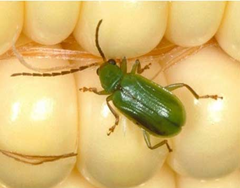The Rootworm Resilience: How Extended Diapause Challenges Rotated Acres
Stuart Carlson, Northern Region Product Agronomist
Stuart Carlson, Northern Region Product Agronomist
There are several reasons why corn can be going down in a field when the previous crop is a non-corn crop. Most growers rotate between corn and soybeans to break up life cycles of diseases and insect pests, improve soil tilth, and manage workload. But this year, many growers are scratching their heads about having corn root lodged in these acres.
The very first thing to do in these situations is to dig up roots. Harvest time is a difficult time to examine roots because of the natural decay, but this is the best place to start. No matter what, if there is a problem, always dig roots first. Five major reasons come to mind for a poor root system: shallow planting depth, slow root growth from excess water, chemical or fertilizer damage, compaction, and insect feeding. This discussion will focus on insect feeding from corn rootworms
Corn rootworm extended diapause refers to a phenomenon within the northern corn rootworm species (Figure 1) where the eggs enter a state of prolonged dormancy. This adaptation allows the eggs to remain viable in the soil for an extended period, often longer than one growing season. The larvae will emerge only when corn is planted again, ensuring they have a food source when they hatch. Most of the time, we only worry about the corn rootworm larvae hatching in the spring, feeding on corn roots during the growing season, pupating, and emerging as adults later in the season to feed on silks and lay eggs.

Extended diapause challenges traditional pest management practices. Relying solely on crop rotation might not be enough. Farmers may need to incorporate additional methods:
Extended diapause can lead to greater challenges for farmers practicing crop rotation as a pest management strategy. If the rootworms survive through a year of rotation (e.g., soybean, wheat, or milo), they will emerge when corn is planted again, potentially causing significant damage. This adaptation has made it more difficult to control corn rootworm populations, even with traditional management practices. This is why many growers are using multiple forms of control.
